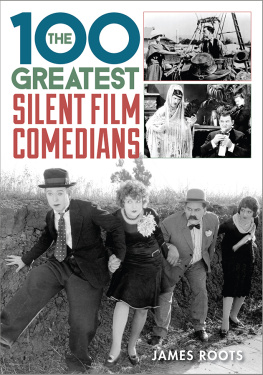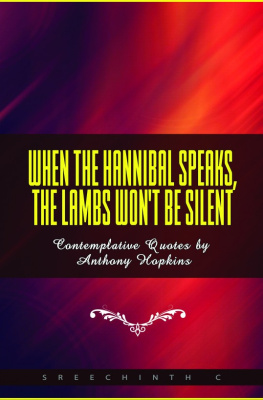To my wife, Debra, who has the beauty of Garbo, the presence of Barrymore, the professionalism of Gish, and the humor of Davies
Acknowledgments
Although I love silent films and have studied them for decades, I do not consider myself to be an expert the subject is simply too vast. Fortunately, I am in touch with some individuals who deserve that designation, none more so than Kevin Brownlow and Anthony Slide. Kevin responded to my many questions with invaluable insight, reflecting his encyclopedic knowledge on the genre. In addition, he was kind enough to provide Silent Lives with its foreword. Tony was equally generous with his advice and constructive criticism.
Then there was Cole Johnson. He spent hours sorting through his Slapstick Archive to furnish scene stills that have rarely, if ever, made it into a film book before now. Coles brother Mark shared his restored newspaper line-art cuts, as did Claudia Sassen. Tim Lussier and David B. Pearson did their part by contributing a number of beautiful portraits.
Other individuals who assisted with photographs and/or research materials include: Laura and Dan Balogh; Alex Bartosh; John Bengtson; Tom Best; Lisa Black; Michael F. Blake; Diana Serra Cary; Brady Cox; Melissa Talmadge Cox; Greta de Groat; Rick Ewing; Leatrice Gilbert Fountain; David Gerstein; Vince Giordano; Bob Gitt; Thomas Gladysz; Steven K. Gragert; Mark A. Greene; Dr. Gene M. Gressley; Theresa Haenelt; Glenn Hanna; Jack Hardy; Miss Daphne Hereford; Donna Hill; Chuck Johnson; Stephanie Jones; David Kiehn; Harry Langdon, Jr.; Jaime Larkin; Keri Leigh; Annette DAgostino Lloyd; Suzanne Lloyd; Bruce Long; Janet Lorenz; Gene Massimo; Dave Mendonca; Peter and Jackie Monticup; Hugh Munro Neely; Steve Rydzewski; Dave and Ali Stevenson; Chris Snowden; Randy Skretvedt; Joe Stehlik; Sheryl Stinchcum; Jim Talmadge; Patricia Eliot Tobias; Linda Wada; Wendy Warwick White; Lloyd Williams; Melynie Withington; and the reference staffs of the American Heritage Center at the University of Wyoming, the Margaret Herrick Library of the Academy of Motion Picture Arts and Sciences, and the Knight Library at the University of Oregon.
Valerie Thompson deserves a special mention for her creative and beautiful book design.
I have been blessed with a select group of cineastes who regularly attend my Silent Film Series at Willamette Oaks Retirement Community in Eugene, Oregon; they have been very supportive of this endeavor. So too have my neighbor Dr. Robert Foster, and my in-laws Charline and Ralph LaCoe. Charline might even have been the subject of one of my profiles had her life taken a different course. When she was very young she lived with her grandmother in Santa Ana, California. Sometime around 1927, Douglas Fairbanks and Mary Pickford turned up in her neighborhood to scout out locations for Marys newest film, My Best Girl. They noticed four-year-old Charline playing in her front yard and felt that she had screen potential. Mary approached Charlines grandmother and offered to adopt the little girl and groom her for stardom. Alas, the offer was refused. Of course, had it been accepted, its more than likely that my wife Debra would never have been born, and then where would I be? Debra assisted me throughout this project by editing my prose, deciding which illustrations made the final cut, patiently coaching me at the computer and providing endless moral support. Shes a rock.
I am eternally grateful to everyone who has helped me with this life-long dream. In particular, I wish to thank Ben Ohmart, the enterprising founder and president of BearManor Media, for making that dream a reality.
Foreword
What is the point of silent films? In an era when we are bombarded with motion pictures, in full color and sound, why bother with the primitive fumblings of the past?
Silent films represent our history. Wouldnt you be thrilled to see authentic moving images of the Civil War? Then why condemn footage of World War One to the trash heap? Silent films represent more authentically than any reconstruction the attitudes and prejudices of their time. This is priceless. And dont imagine they were all nonsensical, girl-tied-to-the-track melodramas. They made a few of those, and a few parodies, too. But the sheer range of what they tackled before talkies is breathtaking. Everything from Roman spectacle to Prohibition drama, from films on drug addiction to massive epics of warfare, documentaries on the struggles of primitive tribes to a reconstruction of the building of the trans-continental railroad.
And silents were never silent. You had orchestras in the first-run picture palaces, and organs in the neighbourhood theatres. And because you supplied the sound effects and the voices, you became a creative contributor. Like ballet or opera, it was what was left out that drew you in. Those fortunate enough to watch a silent film with live orchestra know how unique that experience can be.
And here are the people responsible. Lon Davis has done an excellent job of selection, although inevitably he has omitted some of my favourites (where is Bessie Love?!) Like Lon Davis, I knew many of them. They were the most extraordinary people I have ever met. Of course, by the time I knew them, they were old. But nearly all retained the enthusiasm that inspired them to make pictures in the first place. As I left, exhilarated after each interview, I kept thinking; if they are as exciting as this in old age, what must they have been like when young?
Read the biographies. There are some remarkable stories. And, yes, you will find ammunition for all the myths. Alcohol was so popular it must have been pumped through Hollywoods water pipes and this during Prohibition! Marriages lasted overnight if you were lucky. And as for drugsActually, were you to dissect any small town you would have found the same proportion of eccentricity and nobility. For a community famed for its foolishness, though, I was impressed by the intelligence of these people. It was their dedication to films, however, that endeared them to me. As Buster Keaton said; We ate, slept and dreamed them.
I have studied the silent era longer than it lasted. I have devoted my career to writing books and making documentaries about these people. And yet I am still fascinated by their work as ever. Certainly, I have seen as many bad films as good, and while my enthusiasm may have wilted from time to time, it has always been revived by the sight of the next good picture. For the silent era was full of surprises. I think you will find a few among these biographies.
Kevin Brownlow
London, England
Introduction
It was 1968, the year I turned nine. My father had just returned home with a handful of 8mm reels of old-time comedies. Before long, the flickering images of Roscoe Fatty Arbuckle and Mabel Normand were projected onto our white refrigerator door. To those gathered in the kitchen that evening, this was simply a pleasant diversion; to me, it was the awakening of a life-long passion for silent films.











